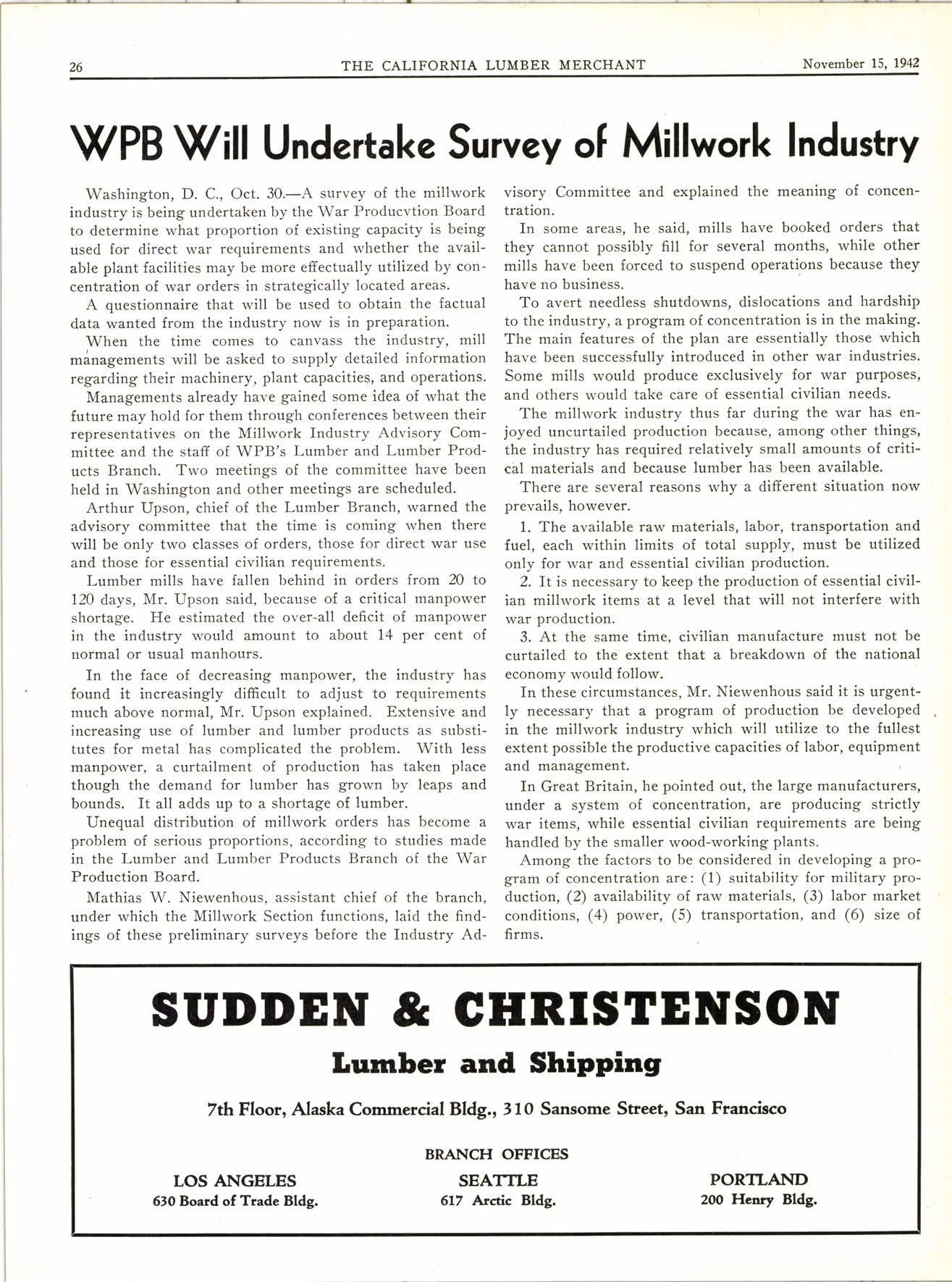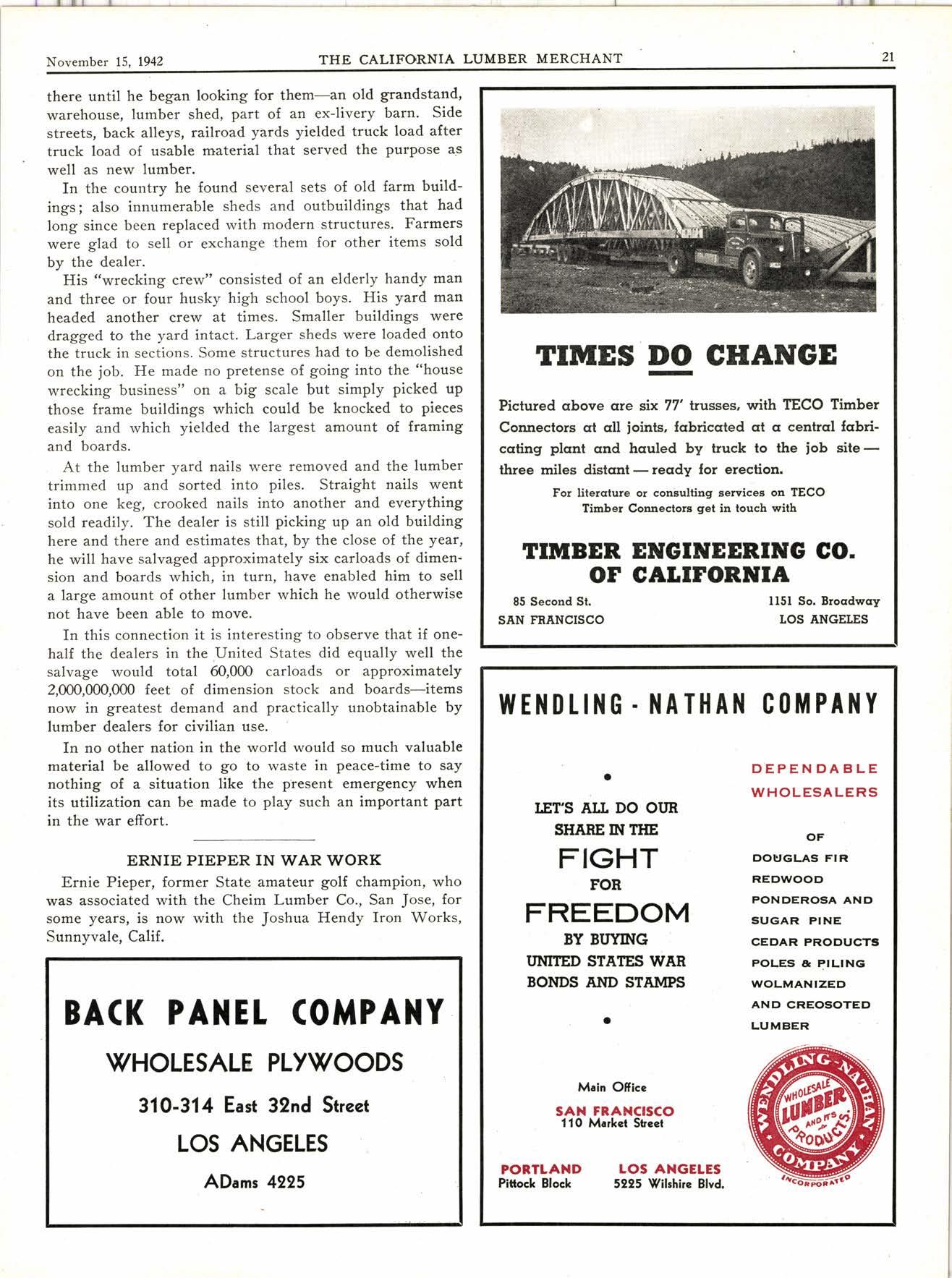
5 minute read
Lumb er lndust ryr Facing Grave Manpo wer Short ager Battles to Meet Mounting War Needs
By Holman Horvey National Lumber Manufacturers Association
Inundated by a growing floodtide of war orders, the lumber industry is engaged today in a monumental struggle on its production line. Never in its history has so much lumber been demanded of it in so short a time.
For, not only is wood going to war itself in more than ,one thousand difierent forms, but, as metals roll away to 'world fronts in staggering amounts, wood is taking over trnany of metal's heavier home-front tasks.
New timber engineering methods which double the formcr structural efficiency of wood, have made it possible for :the Army, Navy, and Maritime Commission to divert a vast volume of metal from construction use to munitions.
The price, of course, has had to be paid. Fortunately, it ,could'be paid out of our immense and only renewable natural resource, our 630 million acres of standing forest land. Since the beginning of the defense program in I94O, we have used for rnetal-replacement alone more than six billion board feet of lumber a year-six billion feet a year which WPB says has released for war purposes' to date, more than 2,500,000 tons of metal.
Consumption Exceeding Production
-In the face of this unprecedented national conversion to wood, the lumber industry has been waging a ceaseless fight for production. But gradually, because of labor diversion and pirating, wearing out and inadequate replacement of ,equipment, and complicated restrictions, the national pror(luction has been slowly declining. Latest available esti-mates compiled by the National Lumber Manufacturers Association, covering the month of August, show national lum,ber consumption four per cent in excess of national produc'tion and the consumption figures did not include exports or readjustments in retail stocks, data on which are not yet available,
The August reported total production of 2,9O/W,m board feet was two per cent below July production.
At the satne time, log stocks and lumber stocks on hand at the nation'a mills continued to shrink under severe buying inroads. On August 31, log inventories in the Pacific Northwest were the lowest on record and, according to the Association, many mills will face shortages this winter. Lumber stocks at mills on the same date were three per ,cent below stocks as of July 31, and 29 per cent below August 31, L94t. Unfilled orders, in the softwood regions, were 78 per cent of gross stocks and, in the hardwood tegions, 34 per cent.
As against this declining total supply, the war agencies estimate that national lumber requirements are four per cent higher than during the past summer, and twelve per cent up over a yeaf ago,
Raw Material Is Plentiful
The lumber production problem is not one of supply of raw material or of mill capacity to convert it into lumber. There is plenty of good timber and ample reserves, and the forest products industries have declared that all necessary lumber can be harvested and the easily accessible forest lands which must be more heavily cut to obtain a speedy supply, can be left in productive condition for regrowth. In some more remote areas, virgin timber stands will be opened up to production by new access roads for which the'Government is advancing funds. No areas need be devastated.
Manpower is the crux of the problem of lumber scarcity. With more and more men needed in logging camps and mills, fewer and fewer have become available. In the great lumbering regions of the 'West, woods operations crews are down 30 per cent in numbers and about 40 per cent in efficiency due to the inexperience of replacement workers. In the South, too, the labor loss has been heavy. Where has this labor gone? The answer given by WPB's Lumber and Lumber Products Branch is that about two-sixths has gone into the draft since last January, three-sixths to other war industries, and one-sixth has been "on the make," working for no one.
After months of warnings {rom the industry that it could not produce lumber without skilled manpower, the Government finally has taken peremptory action on a limited front. Five war agencies, now thoroughly aroused by the declining production curve, have issued directives designed to check the drain, in the West, of essential lumber workers into the armed services and to halt the pirating of lumber labor by other industries. Similar action in the South is known to be in contemplation.
Lumber Workers "Stabilized',
The War Manpower Conrmission, calling for "uninterrupted production" in 12 Western states, issued a stabilization order forbidding essential workers to seek employment in any other industry without first obtaining from the U. S. Employment Service a t'certificate of separation,,, authorizing the worker to leave his job for another.
Selective Service, in a "stay-put-or-fight" order, instructed draft boards in the 12 states immediately to terminate occupational deferments of essential workers who leave their jobs without satisfying their boards that their departure is not adverse to the war effort.
At the same time, Selectivi Service instructed local boards to grant deferments to workers in 68 "critical occupations', in forestry, logging, and lumbering and notified employers that it was their duty to request draft deferment for needed men, with or without the consent of the vdorker. Employers also were urged to take inventories of their remaining manpower and to train women and non-draftable men to replace draftable men wherever possible and as quickly as possible.

WPB directed that the 4O-hour week be extended at once to 48 hours throughout the Pacific Northwest and OPA raised the price ceiling on logs in the same area to absorb the overtime pay involved.
War Procurement Centralized
Another move by the Government, taken af.ter 14 months of urging by the lumber industry, is expected to ease the situation by trimming down lumber requirements and reducing waste of competitive procurement. It is the centralizing of procurement for seven war agencies in the office of the Construction Division of the Army Corps of E4gineers.
In like manner, all hardwoods used in ship construction by any branch of the armed forces will be procured by the Navy.
The importance of these government moves becomes clearer when it is realized that 9O per cent of all lumber shipments now are going into war, defense, and prioritycontrolled essential civilian uses.
But, inevitably, as civilian uses are curtailed in one direction they spring up as essential needs in another. Confronted with the fuel shortage, the Government has been forced to relax its controls on lumber for the weather-proofing of homes with storm-windows and storm doors and wood weatherstripping. Most of the nation's homes are built of wood and these cannot be allowed to go without needed repair. No limit is placed on repair of homes or productive farm buildings.
Great corporations like Westinghouse turn from structural steel to engineered timber for their war factories. The Army turns to wood training planes and wood cargo trucks -wood is needed for ships, gliders, cantonments, war industry housing; for docks, railroad ties and bridges, defense highways and mines; for livestock housing and grain storage; for boxes and crates to carry our weapons overseas.
There is plenty of wood to be harvested from the forests; the lumber industry is all-out in the fight; the outcome rests on the broad shoulders of the lumberiacks.
No New Preference Orders for Private \Var Housing
San Francisco, Oct. D.Instructions have been received by the regional WPB office to issue no new preference orders covering privately financed war housing projects (P-55) nor orders covering remodeling of housing in defense areas (P-110) pending further allocation of criiical material for these purposes.
Preliminary allocations of materials for the fourth quarter for war housing were made by WpB earlier this month. Preference orders issued so far during the quarter have ex_ hausted the supply which WPB feels should be assigned to privately financed new projects and remodeling proj_ ects, according to Washington advi.ces.
The action was taken at the direction of the Office of Program Determination of WpB so that the materials 'lbank accounts" for construction of the types designated would not be overdrawn. This is the same plan being followed in the allocation of materials for othei purpo..J










